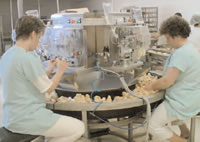



Toward Full Control of Vaccine Administration
by S. Comte, S. Warin and L. Mogenet Ceva Santé Animale, Zone Industrielle de la Ballastière, BP 126, 33501, Libourne, France
Vaccination of birds in the hatchery began in the 1970s to counter huge losses due to Marek’s disease, especially in broilers in the USA. The success that was achieved by this concept of prevention encouraged companies to research and develop new products and equipment for this segment and, over the years, vaccination in hatcheries has become an increasingly important practice in poultry production.
Nowadays, large producing countries like the USA, Brazil and some EU countries achieve 100% of broilers injected in ovo or at day old and sprayed at day old. African, Middle East and Asian countries are also largely practising spray and injection at day old for the control of Newcastle disease.
New generations of vaccine, like immune complex IBD vaccine or Recombinant based on HVT vector against IBDV, Newcastle disease or Laryngotracheitis, are increasing and strengthening interest in hatchery vaccination.
Sophisticated equipment
It is not unrealistic to suppose that in a few years time, 80-90% of broiler vaccines will be administered in the hatchery. Furthermore, more and more sophisticated vaccination equipment is being made available for day old injection and spray. These tools improve the quality and comfort of vaccination.
If we consider the cost of investment in tools and specialised employees in the hatchery, one can ask what are the reasons for this move from farm to hatchery vaccination?
Evolution of genetics.
In the broiler industry, for instance, the age of slaughter of birds has been reduced over the last 30 years at a rate of one day per year due to genetic improvement and it has increased the relative importance of hatcheries in the whole process of production.
Infectious pressure.
Very early vaccination is crucial to counter early challenge of respiratory virus such as Newcastle disease (ND), infectious bronchitis (IB) and Marek’s disease on the farm. For Marek’s disease, a high field infectious pressure will prompt chick vaccination as soon as possible – upon hatching, or even before – in order to gain precious hours or days on wild viruses.
As vaccine viruses usually multiply slower than their wild cousins, they will have more time to stimulate the young bird’s immunity.
For ND and IB, the hatchery is a unique place to deliver by spray an accurate first priming of the general and local immunity of the day old chicks – immunity which is so critical in the protection against these respiratory diseases. Or, furthermore, to accurately deliver a long lasting inactivated vaccine, for example against ND, as practiced in Africa, the Middle East and Asia.
Difficulties of farm vaccination.
The quality of vaccination at farm level can vary tremendously from farm to farm and round to round.
Producers and vaccine suppliers have put much effort into training technicians and farmers in good vaccination practices. Production managers are working daily on planning and controlling vaccine administration. However, spray and drinking water vaccination at farm level remain difficult exercises. They are time consuming and influenced by many factors like temperature and the quality of the water and materials. This induces a certain variability in the vaccination results and a number of unexplained failures.
Management of people.
Looking at management of people, it is easier to train and to manage a crew of 10- 15 dedicated people at hatchery level, than to train and monitor as many farmers as production requests. The availability of modern vaccination tools, in controlled and dedicated places within the hatchery, enforces professionalism and specialisation of vaccination, allowing better control of the process worldwide. Sanitary controls, staff training and supervision comply more easily to stricter requirements at the hatchery than on the farm.
New generation of vaccines.
Marek’s disease, Newcastle disease and infectious bronchitis vaccination at day old are very classical practices at hatchery level.
For the past five years, vaccine companies have made new generations of vaccines available allowing complete and early vaccination through a single dose administration at hatchery level. These vaccines are the IBD immune complex vaccine or the HVT recombinant vaccine against IBD, ND or LT.
For example, the injection of a vaccine against infectious bursal disease (such as the immune complextype – Cevac Transmune IBD) at the hatchery offers the twofold advantage of having an accurate dose administered to each bird and the individual release of the vaccine virus, depending on the level of maternally derived antibodies of each chick.
This type of vaccine suppresses the need for determining vaccination dates and avoids the risks related to drinking water farm vaccination, for example the presence of disinfectant or metal ions in the vaccine water, too long or too short water fasting, wrong calculation of the amount of vaccine solution, incorrect date of vaccination, breakdown in the cold chain during transport to or storage on the farm of the vaccine, vaccine freezing, broken vials, expired vaccines, use of metallic containers or whisks.
This improved control of both vaccine administration and individual vaccine take allows homogenous coverage of the bird population and results in better control of deleterious effects of IBD on flock performances.
Challenges ahead
No matter why companies adopt hatchery vaccination, it must be clear that it has its own challenges and some care should be taken to ensure good results.
Hatchery vaccination will require changes in hatchery organisation and in the relation between the hatchery and field production.
Vaccine protection relies on the quality of the hatchery work on the hatching day – missed birds will, most of the time, be unprotected birds.
Ultimately, it requires financial investment in equipment and man power superior to that of on farm vaccination.
At the end of the day, as a further step in intensification and risk control in poultry production, hatchery vaccination appears more and more as the solution towards full control of vaccine administration, bird protection and, as a consequence, production performance.












